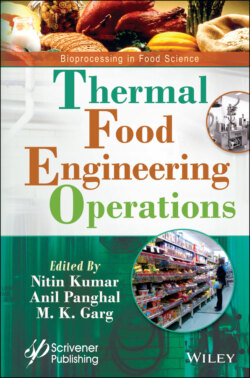Читать книгу Thermal Food Engineering Operations - NITIN KUMAR - Страница 36
2.1 Introduction
ОглавлениеFood quality and safety have a long history and are continuing as the major concerns for preservation and targeting microorganisms. The chief cause for any type of deterioration of food products is microorganisms, and therefore inhibition of these are targeted using different methods by the food industries [1]. Varied techniques of food preservation have been utilized for centuries to avert poisoning and degradation of the food. With the passing phase, the new models and techniques are evolved promising to avert the degradation by inactivating microorganisms. But then again slowing down or terminating the growth of microorganisms will not ensure the proper safety of the food until and unless the environment is taken care of, like maintaining a cold chain throughout. Processing the food by application of heat has extended antiquity for the inactivation of microorganisms and is still considered as the utmost significant method of preservation [2]. Louis Pasteur introduced pasteurization in the late 19th century to eradicate spoilage-causing organisms and with the passing of time, new science-based heat processing emerged.
In the old heating process, the stability of the microbes was often quite high but the knowledge of the kinetics for different microbes was relevant. Traditional canning methods aim at the destruction of all spores (sterilization) or of all spores that can grow in the container below 40°C (commercial sterilization or appreciation) [3]. With the rising customer request for fresh products, industries are giving special attention to the heat resistance of spores from sensitive cold growing spores and finding ways for minimal processing with an amalgamation of facilities for cold storage and improved shelf life [4]. Quite a few sterilization methods have already been utilized by most of the food industry, the objective of which is to inactivate the microorganism from which the most common form of destruction is targeting the DNA of the microbial cell and destroying it in both liquid and solid food products through denaturation [5] did a study and concluded that the denaturation process requires high heat for 15 s at 71.06 °C accompanied by drying with air inlet temperature extending from 135 to 205 °C for 5–6 s.
Several works have been carried out during the past decades aiming to inhibit the growth of the foodborne pathogens in varied products. However, some of the traditional thermal treatments, al though they carefully inactivate all the microbes and extend the shelf life of the food, are still not favored as they cause degrading effects to the nutritional properties of the food product such as deterioration of the antioxidant compounds, flavor, proteins vitamins and volatile oils [6]. Therefore, intensive studies were investigated for developing new alternative conventional techniques which offer better preservation of food, maintaining the color, texture, nutritional quality, and flavor of the food product. In the accumulation of environmental and food safety concerns techniques which evolved as an innovative thermal preservative method in agricultural and food applications are ohmic heating, radiofrequency heating, microwave heating, infrared heating, and instant control pressure drop technology [7–9]. These physical factors can cause the inactivation of microorganisms at ambient or sublethal temperatures.
The major objective is to gather the knowledge of all the techniques, mechanisms of inactivation, and factors affecting the physical and orogenetic parameters of the particular food products. Furthermore, predicting kinetics and microbial nature during the application of varieties of different techniques through mathematical modeling is also considered the most vital tool in the food matrix. Therefore, the chief goal of this chapter is to provide a record that will provide data of the food degrading organisms, its quantitative behavior portrayal for different food matrix with varied environmental setup and besides with the pre-assumed mechanism of different alternative thermal techniques involved.
The final goal, however, is to answer the question of whether the microorganisms are inactivated after nonthermal processing. Although mathematical descriptions of heat inactivation date already from the early 20s, the development of new software during the last decades enables a better description of inactivation kinetics under different conditions. Combined with better control of temperature in each container a milder heat process can be designed without compromising microbial safety and stability [10]. The principles of modeling death kinetics will be addressed within the framework of quantitative microbiological risk assessment. The effect of environmental conditions and their extrapolation to real food situations will also be discussed.
